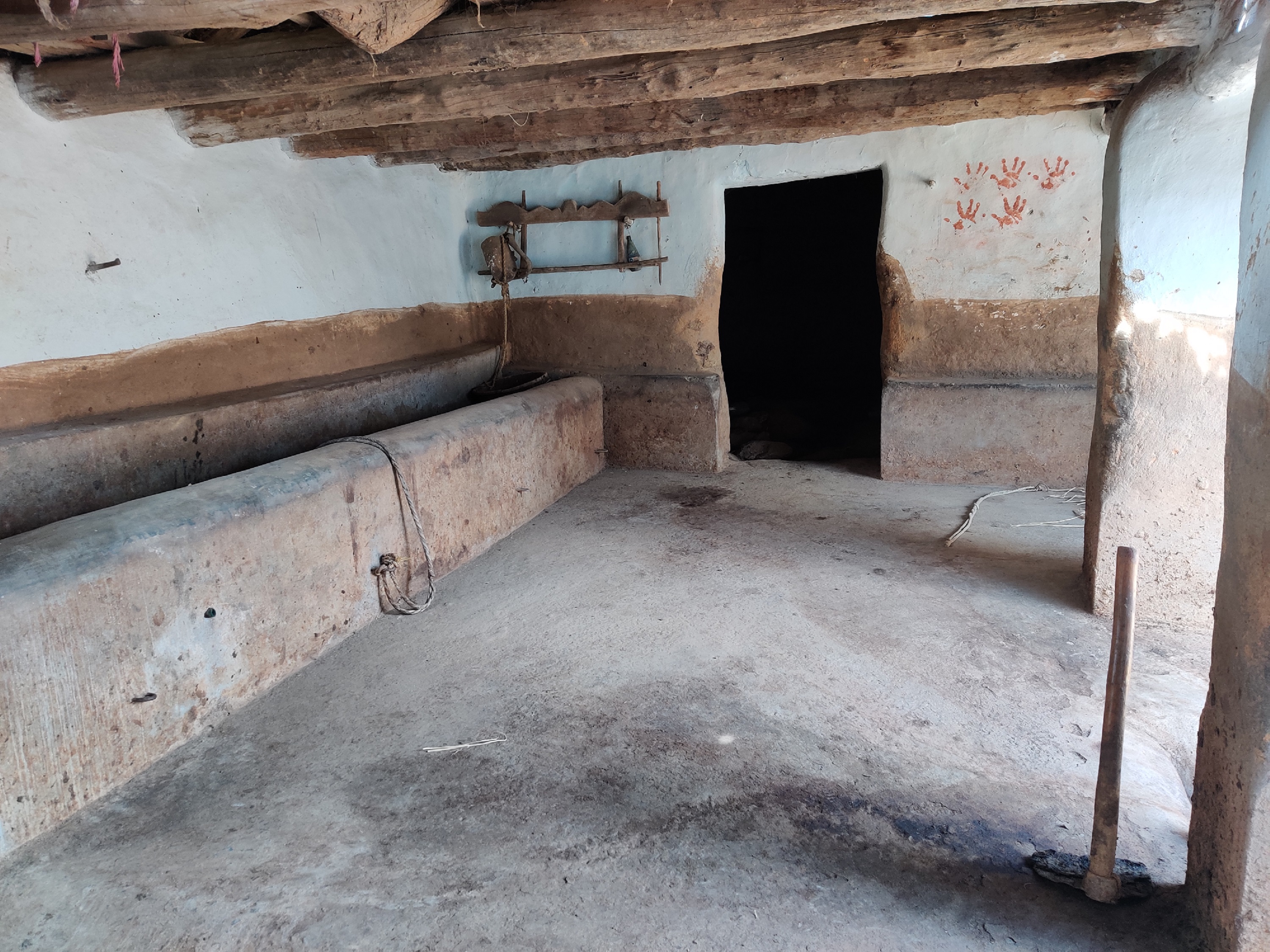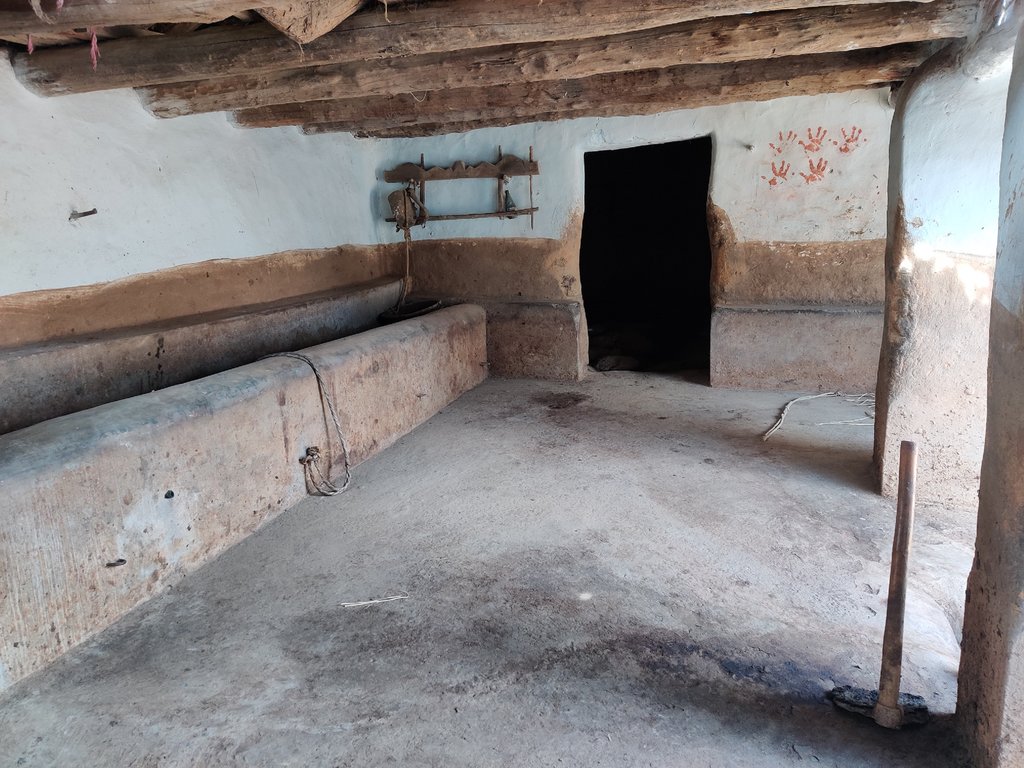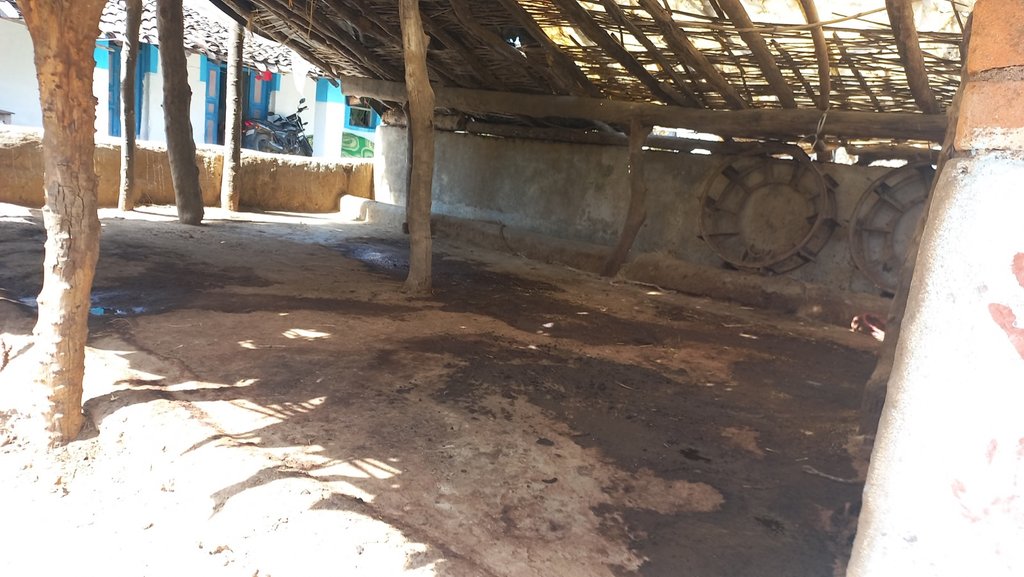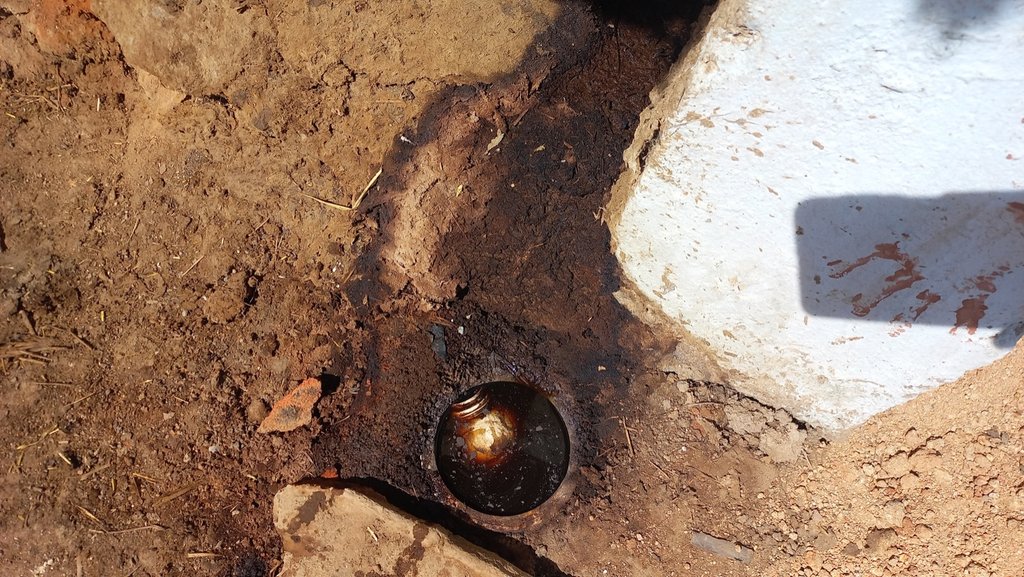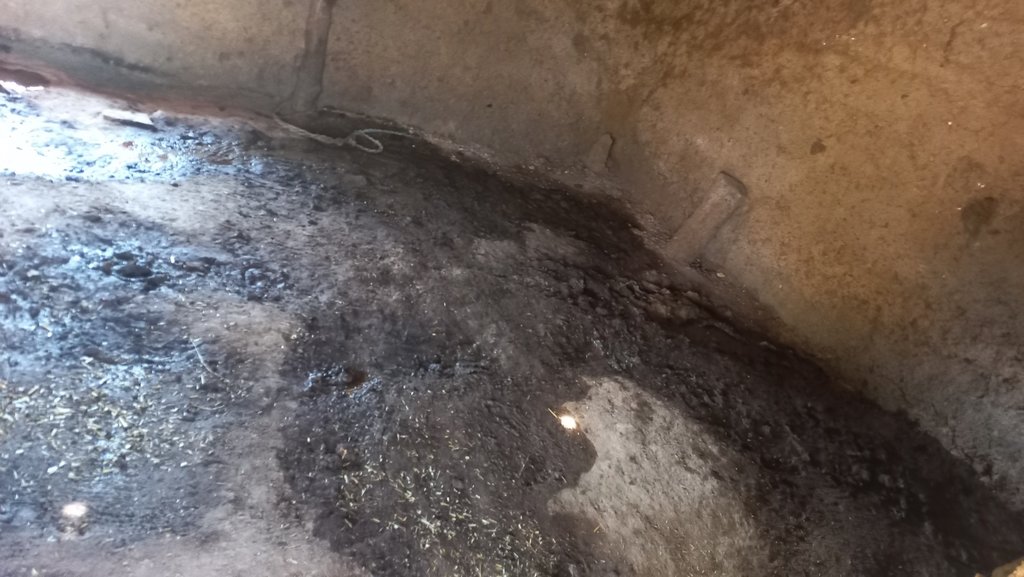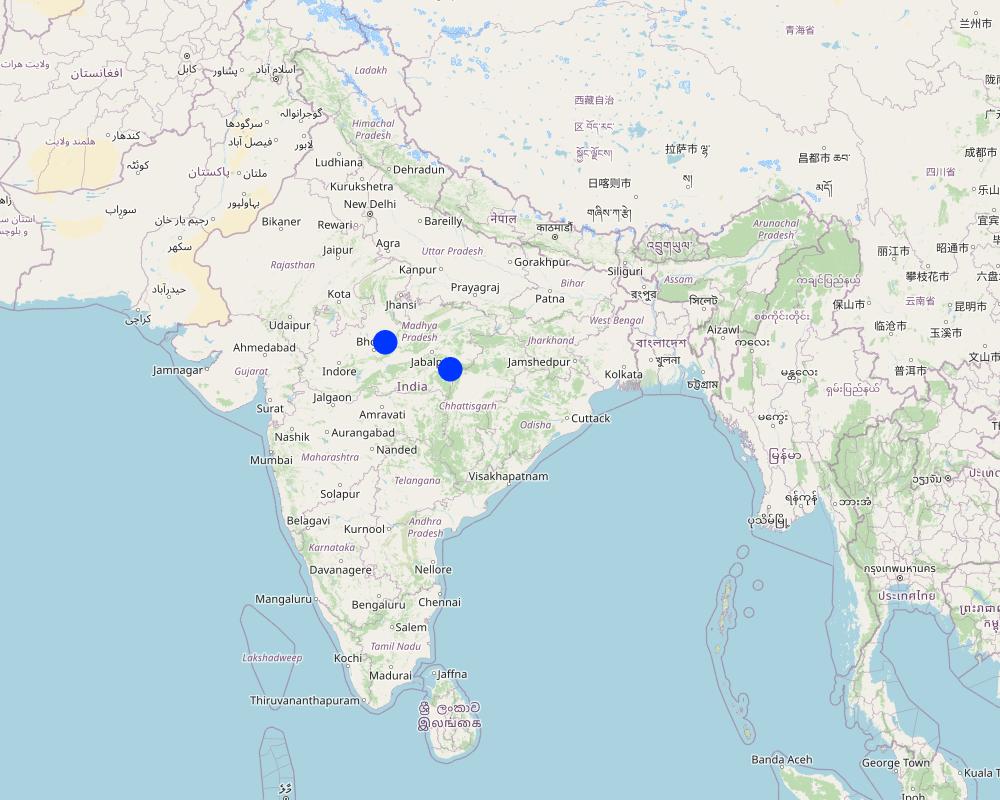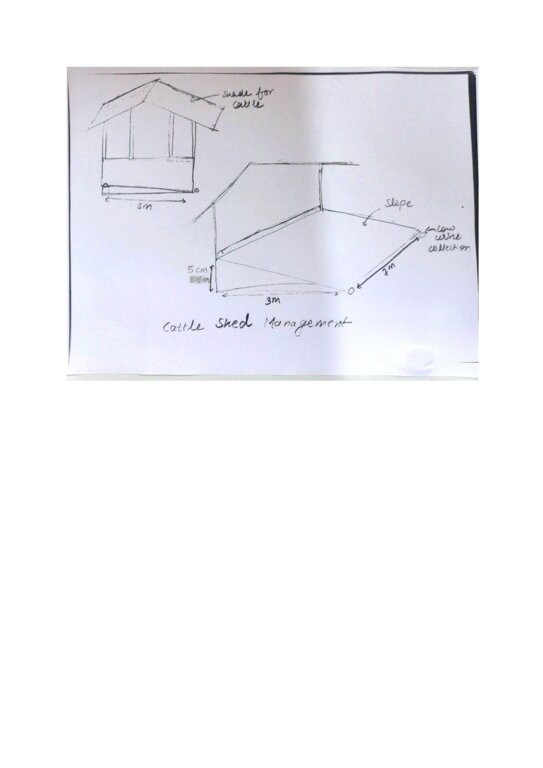Improved Cattle Shed Flooring for Conservation of Cow Dung and Urine for Biofertilizer Production at Farm Level [ប្រទេសឥណ្ឌា]
- ការបង្កើត៖
- បច្ចុប្បន្នភាព
- អ្នកចងក្រង៖ Santosh Gupta
- អ្នកកែសម្រួល៖ Noel Templer, Stephanie Katsir, Kim Arora
- អ្នកត្រួតពិនិត្យច្រើនទៀត៖ Udo Höggel, Joana Eichenberger
technologies_6721 - ប្រទេសឥណ្ឌា
- សង្ខេបជា PDF
- សេចក្តីសង្ខេបពេញលេញជាទម្រង់ PDF សម្រាប់បោះពុម្ព
- សេចក្តីសង្ខេបពេញលេញទម្រង់អ៊ីនធឺនេត
- សេចក្តីសង្ខេបពេញលេញ (មិនមានទម្រង់ជាក់លាក់)
- Improved Cattle Shed Flooring for Conservation of Cow Dung and Urine for Biofertilizer Production at Farm Level: 25 ខែ មិថុនា ឆ្នាំ 2023 (inactive)
- Improved Cattle Shed Flooring for Conservation of Cow Dung and Urine for Biofertilizer Production at Farm Level: 14 ខែ កញ្ញា ឆ្នាំ 2023 (inactive)
- Improved Cattle Shed Flooring for Conservation of Cow Dung and Urine for Biofertilizer Production at Farm Level: 11 ខែ មេសា ឆ្នាំ 2024 (public)
ពិនិត្យមើលគ្រប់ផ្នែក
ពង្រីកមើលទាំងអស់ បង្រួមទាំងអស់1. ព័ត៌មានទូទៅ
1.2 ព័ត៌មានលម្អិតពីបុគ្គលសំខាន់ៗ និងស្ថាប័នដែលចូលរួមក្នុងការវាយតម្លៃ និងចងក្រងឯកសារនៃបច្ចេកទេស
ឈ្មោះគម្រោងដែលបានចងក្រងឯកសារ/ វាយតម្លៃលើបច្ចេកទេស (បើទាក់ទង)
Soil protection and rehabilitation for food security (ProSo(i)l)ឈ្មោះអង្គភាពមួយ (ច្រើន) ដែលបានចងក្រងឯកសារ/ វាយតម្លៃបច្ចេកទេស (បើទាក់ទង)
Deutsche Gesellschaft für Internationale Zusammenarbeit (GIZ) GmbH (GIZ) - ប្រទេសអាល្លឺម៉ង់ឈ្មោះអង្គភាពមួយ (ច្រើន) ដែលបានចងក្រងឯកសារ/ វាយតម្លៃបច្ចេកទេស (បើទាក់ទង)
Alliance Bioversity and International Center for Tropical Agriculture (Alliance Bioversity-CIAT) - ប្រទេសកេនយ៉ាឈ្មោះអង្គភាពមួយ (ច្រើន) ដែលបានចងក្រងឯកសារ/ វាយតម្លៃបច្ចេកទេស (បើទាក់ទង)
Ecociate Consultants (Ecociate Consultants) - ប្រទេសឥណ្ឌា1.3 លក្ខខណ្ឌទាក់ទងទៅនឹងការប្រើប្រាស់ទិន្នន័យដែលបានចងក្រងតាមរយៈ វ៉ូខេត
អ្នកចងក្រង និង(បុគ្គលសំខាន់ៗ)យល់ព្រមទទួលយកនូវលក្ខខណ្ឌនានាទាក់ទងទៅនឹងការប្រើប្រាស់ទិន្នន័យដែលបានចងក្រងតាមរយៈវ៉ូខេត:
បាទ/ចា៎
1.4 សេចក្តីប្រកាសស្តីពីចីរភាពនៃការពណ៌នាពីបច្ចេកទេស
តើបច្ចេកទេសដែលបានពណ៌នានេះមានបញ្ហាដែលផ្តោតលើការធ្លាក់ចុះគុណភាពដី, បើដូច្នេះវាមិនអាចត្រូវបានប្រកាសថាជាបច្ចេកទេសនៃការគ្រប់គ្រងប្រកបដោយចីរភាពទេ?
ទេ
2. ការពណ៌នាពីបច្ចេកទេស SLM
2.1 ការពណ៌នាដោយសង្ខេបពីបច្ចេកទេស
និយមន័យបច្ចេកទេស:
In the cattle shed management system, the cattle shed should be constructed with an elevated concrete floor that slopes slightly toward a cow urine collection point. The collection point should be equipped with a drainage system to easily remove cow dung and urine.
An elevated concrete floor for cow dung and urine collection can improve hygiene, and waste management, and reduce labour costs in cattle sheds. Collected cow urine and cow dung can be used to prepare biological inputs and compost for nutrient and pest management in agriculture.
2.2 ការពណ៌នាលម្អិតពីបច្ចេកទេស
ការពណ៌នា:
Cattle shed management technology, including the use of a concrete elevated floor for cow dung and urine collection, is a cost-effective and efficient technology to support the natural farming system. This technology can be applied in both natural and human environments. In natural environments, such as rural or agricultural areas, cattle sheds are typically used for dairy and farmyard manure production. The use of this technology can improve the hygiene of cattle and their environment, reduce waste and pollution, and promote the sustainable use of natural resources. The cow dung and urine so collected can be used as fertilizer to improve soil quality, and the improved hygiene of the cattle can reduce the risk of diseases spreading to other animals or humans. The use of this technology can help to reduce the negative impacts of cattle farming on the surrounding environment, such as odours and pollution. It can also improve the hygiene of the cattle and their environment, which is important for both animal welfare and public health.
Traditionally farmers were constructing the floors of cattle sheds using mud and soil. These floors absorb the cow urine and the movement of animals also makes holes in it because of that cow urine and cow dung are used to get filled in these halls. Which made the entire floor unhygienic for both animals and farmers. Because of such surfaces, it was very hard to clean these sheds. The use of an elevated floor made with cement-concrete and a waste management system can help to keep the cattle shed clean and dry, which can reduce the risk of disease and infection among the animals. The collection and disposal of cow dung and urine can help preventing environmental pollution, reducing the negative impacts of cattle farming on the surrounding area, and promoting sustainable use of natural resources. The use of a concrete elevated floor can make cleaning the cattle shed faster and easier, reducing labour costs and improving the efficiency of the farming operation.
Technical specifications for the construction of cattle sheds can vary depending on factors such as the size of the herd, local environmental regulations, and available resources. However, in general, the main characteristics and elements of cattle shed management technology are designed to promote animal welfare, hygiene, waste management, and sustainability. Proper cattle shed management technology can provide a comfortable and safe environment for the animals, which can reduce stress and promote animal welfare. Proper waste management and ventilation can help to minimize unpleasant odours from the cattle shed, which thus reduces negative impacts on the surrounding community.
Establishing and maintaining cattle shed management technology requires a combination of technical expertise, labour, and resources. By investing in these inputs, farmers can promote sustainable and efficient cattle farming practices and improve the health and welfare of their animals.
The collected cow urine and cow dung are the main resources for preparing the biological inputs and different types of compost for meeting the nutritional requirement of crops while also addressing the challenges of pest and disease management in a natural or organic farming system. The improved flooring of cow shed units has been a great intervention to replace and reduce the usage of synthetic fertilisers and pesticides in the project region.
The views of land users, such as farmers or livestock keepers, about cattle shed management technology, including the use of a concrete elevated floor for cow dung and urine collection, can vary depending on their experiences and perceptions. The interviewed land user liked or appreciated, cattle shed management for improving animal health and productivity, increasing farm profitability, cleaning the cattle shed easier and faster, reducing labour costs, improving efficiency, and for environmental benefits.
2.3 រូបភាពនៃបច្ចេកទេស
កំណត់សម្គាល់ទូទៅនៃរូបថត/រូភាព:
All of these phots have been taken with the consent of participants.
2.4 វីដេអូនៃបច្ចេកទេស
ការពណ៌នាសង្ខេប:
https://youtube.com/watch?v=Gd6u8yZ9DqY&si=EnSIkaIECMiOmarE
កាលបរិច្ឆេទ:
01/02/2021
ទីតាំង:
Mandla, Madhya Pradesh, India
ឈ្មោះអ្នកថតវីឌីអូ:
Soil Matters
2.5 ប្រទេស/តំបន់/ទីតាំងកន្លែង ដែលបច្ចេកទេសត្រូវបានអនុវត្ត និងបានគ្រប់ដណ្តប់ដោយការវាយតម្លៃនេះ
ប្រទេស:
ប្រទេសឥណ្ឌា
តំបន់/រដ្ឋ/ខេត្ត:
Madhya Pradesh
បញ្ជាក់បន្ថែមពីលក្ខណៈនៃទីតាំង:
Mandla District
បញ្ជាក់ពីការសាយភាយនៃបច្ចេកទេស:
- អនុវត្តនៅកន្លែងជាក់លាក់មួយ/ ប្រមូលផ្តុំនៅតំបន់តូចៗ
តើបច្ចេកទេស (មួយ ឬច្រើន) ទាំងនោះស្ថិតនៅក្នុងតំបន់ការពារជាអចិន្ត្រៃយ៍ណាមួយដែរឬទេ?
ទេ
មតិយោបល់:
The technology is being adopted by more than 100 farmers across the 10-15 villages of the Bichhiya block in Mandla District of Madhya Pradesh
Map
×2.6 កាលបរិច្ឆេទនៃការអនុវត្ត
ប្រសិនបើមិនច្បាស់ឆ្នាំ សូមបញ្ជាក់កាលបរិច្ឆេទដែលប្រហាក់ប្រហែល:
- តិចជាង 10ឆ្នាំមុន (ថ្មី)
2.7 ការណែនាំពីបច្ចេកទេស
សូមបញ្ជាក់តើបច្ចេកទេសត្រូវបានណែនាំឱ្យអនុវត្តដោយរបៀបណា:
- តាមរយៈគម្រោង / អន្តរាគមន៍ពីខាងក្រៅ
មតិយោបល់ (ប្រភេទនៃគម្រោង ។ល។):
Initially, the project supported the farmers in the construction of cemented cow shed floors in a limited area. However, there has also been investment from the users either by putting extra funds to extend the area or by contributing labour.
3. ចំណាត់ថ្នាក់នៃបច្ចេកទេស SLM
3.1 គោលបំណងចម្បង (១ ឬច្រើន) នៃបច្ចេកទេសនេះ
- ធ្វើឱ្យប្រសើរឡើងនូវផលិតកម្ម
- កាត់បន្ថយ, បង្ការ, ស្តារឡើងវិញនូវការធ្លាក់ចុះគុណភាពដី
- អភិរក្សប្រព័ន្ធអេកូឡូស៊ី
- បង្កើតផលប្រយោជន៍សេដ្ឋកិច្ច
- Control cattle diseases
3.2 ប្រភេទដីប្រើប្រាស់មួយប្រភេទ (ច្រើនប្រភេទ) ដែលបានអនុវត្តបច្ចេកទេស
ដីប្រើប្រាស់ចម្រុះនៅលើដីតែមួយ:
ទេ

ដីដាំដំណាំ
- ដំណាំប្រចាំឆ្នាំ
ដំណាំប្រចាំឆ្នាំ - បញ្ជាក់ប្រភេទដំណាំ:
- ធញ្ញជាតិ - ពោត
- ធញ្ញជាតិ - ស្រូវ (តំបន់ដីសើម)
- ធញ្ញជាតិ - ស្រូវសាលី (សិសិររដូវរងារ)
- legumes and pulses - lentils
- ដំណាំដែលមានគ្រាប់ចម្រាញ់ប្រេងបាន - ផ្កាឈូករ័ត្ន ផ្កា rapeseed ផ្សេងៗ
- បន្លែ - បន្លែយកស្លឹក (សាលាដ ស្ពៃក្តោប ផ្ទី ផ្សេងៗ)
ចំនួនសារដែលដាំដំណាំក្នុងមួយឆ្នាំ:
- 2
សូមបញ្ជាក់:
In kharif (summer) season farmers are sowing paddy in wetlands and in rabi (winter) season wheat, chickpea, mustard, maize and other vegetables
តើជាការអនុវត្តន៍ដំណាំចន្លោះ?
បាទ/ចា៎
ប្រសិនបើបាទ/ច៎ា សូមបញ្ជាក់ប្រភេទដំណាំដែលដាំចន្លោះគ្នានោះ:
Chickpea intercropping with beans, mixed cropping system of vegetables present
តើជាការអនុវត្តន៍ដំណាំវិលជុំ?
បាទ/ចា៎
បើបាទ/ច៎ា សូមបញ្ជាក់:
Rice- Chickpea
Rice-Wheat
Rice- Maize
មតិយោបល់:
The intervention is mostly focused on improved cattle shed units. However, collected cow urine and cow dung are good for restoring the degraded agricultural land.
3.3 បន្ទាប់ពីអនុវត្តបច្ចេកទេស តើដីប្រើប្រាស់មានការប្រែប្រួលដែររឺទេ?
បន្ទាប់ពីអនុវត្តបច្ចេកទេស តើដីប្រើប្រាស់មានការប្រែប្រួលដែររឺទេ?
- ទេ (បន្តទៅសំណួរ 3.4)
3.4 ការផ្គត់ផ្គង់ទឹក
ការផ្គត់ផ្គង់ទឹកនៅកន្លែងអនុវត្តបច្ចេកទេស:
- ទឹកភ្លៀង និងប្រព័ន្ធស្រោចស្រព
មតិយោបល់:
For irrigation, most of the farmers were dependent upon rain in the Kharif and Rabi season. Some of the farmers were using additional irrigation during critical crop stages by using water canals.
3.5 ក្រុម SLM ដែលបច្ចេកទេសស្ថិតនៅក្នុង
- ការគ្រប់គ្រងដោយរួមបញ្ចូលការដាំដំណាំ និងការចិញ្ចឹមសត្វ
- ការគ្រប់គ្រងជីជាតិដីតាមបែបចម្រុះ
3.6 វិធានការ SLM ដែលបញ្ចូលនូវបច្ចេកទេស

វិធានការក្សេត្រសាស្ត្រ
- A2: សារធាតុសរីរាង្គ/ជីជាតិដី
- A6: ការគ្រប់គ្រងកាកសំណល់
A6: បញ្ជាក់ពីការគ្រប់គ្រងកាកសំណល់:
A 6.4: រក្សាទុក

វិធានការរចនាស័ម្ពន្ធ
- S9: រោងដំណាំ និងរោងចិញ្ចឹមសត្វ

វិធានការគ្រប់គ្រង
- M6: ការគ្រប់គ្រងសំណល់ (កែឆ្នៃទ្បើងវិញ ប្រើប្រាស់ឡើងវិញ ឬបន្ថយការប្រើប្រាស់)
មតិយោបល់:
The implemented technology led to the management and use of waste for productive purposes. While it has improved the productivity of animals by reducing the occurrence of diseases, it has also enabled the preparation of organic inputs to replace the synthetic fertilisers in farming.
3.7 កំណត់ប្រភេទនៃការធ្លាក់ចុះគុណភាពដីសំខាន់ៗដែលបច្ចេកទេសនេះបានដោះស្រាយ

ការធ្លាក់ចុះសារធាតុគីមីក្នុងដី
- Cn: ការថយចុះជីជាតិ និងកាត់បន្ថយបរិមាណសារធាតុសរីរាង្គ (មិនកើតឡើងដោយការហូរច្រោះទេ)

ការធ្លាក់ចុះជីវសាស្ត្រនៃដី
- Bp: ការកើនឡើងនូវសត្វល្អិត ឬជំងឺ បាត់បង់នូវសត្វមានប្រយោជន៍

ការបាត់បង់ទឹក
- Hp: ការថយចុះគុណភាពទឹកនៅលើផ្ទៃដី
- Hq: ការថយចុះគុណភាពទឹកនៅក្រោមដី
មតិយោបល់:
Proper collection of cow dung and cow urine minimised run-off these substance and mixing with surface water used for various purposes including drinking water.
3.8 ការពារ កាត់បន្ថយ ឬស្តារឡើងវិញនៃការធ្លាក់ចុះគុណភាពដី
បញ្ជាក់ពីគោលដៅរបស់បច្ចេកទេស ដែលផ្តោតទៅការធ្លាក់ចុះគុណភាពដី:
- ការការពារការធ្លាក់ចុះគុណភាពដី
- ការកាត់បន្ថយការធ្លាក់ចុះគុណភាពដី
មតិយោបល់:
Application of cow urine and cow dung in soil by mixing with other organic matters improves the soil health and also reduces the dependency on synthetic fertilisers and pesticides
4. បច្ចេកទេសជាក់លាក់ សកម្មភាពអនុវត្ត ធាតុចូល និងថ្លៃដើម
4.1 គំនូសបច្ចេកទេសនៃបច្ចេកទេសនេះ
លក្ខណៈពិសេសនៃបច្ចេកទេស (ទាក់ទងនឺងគំនូរបច្ចេកទេស):
Dimensions of the cowshed (depending on the number of cows kept):
Length: 7m
Width: 3m
Elevated: 5 cm (means in effect the slope: i.e. the front floor of the cowshed is 5 cm higher than the floor at the end, where dung and urine get collected)
ឈ្មោះអ្នកនិពន្ធ:
Payal Dewangan
កាលបរិច្ឆេទ:
22/02/2023
4.2 ព័ត៌មានទូទៅដែលពាក់ព័ន្ធនឹងការគណនាធាតុចូល និងថ្លៃដើម
កំណត់របៀបនៃការគណនាថ្លៃដើម និងធាតុចូល:
- ក្នុងឯកតាបច្ចេកទេស
បញ្ជាក់ឯកតា:
one cattle shed
បញ្ជាក់ពីទំហំនៃឯកតា (បើពាក់ព័ន្ធ):
meter
ផ្សេងៗ/ រូបិយប័ណ្ណជាតិ (បញ្ជាក់):
Indian Rupee
បើពាក់ព័ន្ធសូមកំណត់អត្រាប្តូរប្រាក់ពីដុល្លាទៅរូបិយប័ណ្ណតំបន់ (ឧ. 1 ដុល្លារ = 79.9 រៀលនៃរូបិយប័ណ្ណប្រេស៊ីល) ៖ 1 ដុល្លារ =:
82,24
កំណត់ថ្លៃឈ្នួលជាមធ្យមនៃការជួលកម្លាំងពលកម្មក្នុងមួយថ្ងៃ:
240
4.3 សកម្មភាពបង្កើត
| សកម្មភាព | រយៈពេល (រដូវកាល) | |
|---|---|---|
| 1. | Concrete floor construction for cattle shed | March |
| 2. | Cattle shed roof development | April |
4.4 ថ្លៃដើម និងធាតុចូលដែលត្រូវការសម្រាប់ការបង្កើតបច្ចេកទេស
ប្រសិនបើមិនអាចបំបែកតម្លៃដើមក្នុងតារាងខាងក្រោមទេ សូមផ្តល់នូវតម្លៃប៉ាន់ស្មានសរុបក្នុងការបង្កើតបច្ចេកទេសនោះ:
28000,0
ប្រសិនបើអ្នកប្រើប្រាស់ដីមិនមានថ្លៃដើម 100% សូមបញ្ជាក់ថានរណាដែលចំណាយថ្លៃដើមដែលនៅសល់:
Gram Paryavaran Samiti and Prakritik Sansadhan Prabhandhan Samiti
មតិយោបល់:
Village groups were formed for the implementation of the technology
4.5 សកម្មភាពថែទាំ
| សកម្មភាព | ពេលវេលា/ ភាពញឹកញាប់ | |
|---|---|---|
| 1. | Cleaning of concrete floor | Once in a day |
| 2. | Collection of cow dung | Once in a day |
| 3. | collection of cow urine from the pit or drum | Twice in a week |
| 4. | Fodder and drinking water provision | Twice in a day |
4.7 កត្តាសំខាន់បំផុតដែលមានឥទ្ធិពលដល់ការចំណាយ
ពណ៌នាពីកត្តាប៉ះពាល់ចម្បងៗទៅលើថ្លៃដើម:
Design and technical specifications: The cost of the technology can vary depending on the design and technical specifications of the cattle shed, including the size and materials used.
Construction materials and labor costs: The cost of construction materials and labor can vary depending on local market conditions and availability.
Location: The cost of transporting materials and labor to the construction site can vary depending on the location of the farm.
Maintenance and repair costs: The cost of maintaining and repairing the cattle shed can also add to the overall cost of the technology.
Training and capacity building: Providing training and capacity building to farmers and workers on proper cattle shed management techniques can add to the overall cost of the technology.
5. លក្ខណៈបរិស្ថានធម្មជាតិ និងមនុស្ស
5.1 អាកាសធាតុ
បរិមាណទឹកភ្លៀងប្រចាំឆ្នាំ
- < 250 មម
- 251-500 មម
- 501-750 មម
- 751-1,000 មម
- 1,001-1,500 មម
- 1,501-2,000 មម
- 2,001-3,000 មម
- 3,001-4,000 មម
- > 4,000 មម
កំណត់បរិមាណទឹកភ្លៀង (បើដឹង) ជា មីលីម៉ែត្រ:
1427,00
លក្ខណៈពិសេស/ មតិយោបល់លើរដូវភ្លៀង:
Highest rainfall occurs between June to September.
បញ្ជាក់ឈ្មោះឯកសារយោងនៃស្ថានីយឧតុនិយម:
Mandla, Madhya Pradesh
តំបន់កសិអាកាសធាតុ
- មានភ្លៀងតិចតួច
The climate of the District is tropical, with moderate winters, severe summers, and well-distributed rainfall received from the southwest monsoon. However, due to higher general elevation and abundance of forests, summer temperatures do not rise as much as in other areas.
5.2 សណ្ឋានដី
ជម្រាលជាមធ្យម:
- រាបស្មើ (0-2%)
- ជម្រាលតិចតួច (3-5%)
- មធ្យម (6-10%)
- ជម្រាលខ្ពស់បន្តិច (11-15%)
- ទីទួល (16-30%)
- ទីទួលចោត (31-60%)
- ទីទួលចោតខ្លាំង (>60%)
ទម្រង់ដី:
- ខ្ពង់រាប
- កំពូលភ្នំ
- ជម្រាលភ្នំ
- ជម្រាលទួល
- ជម្រាលជើងភ្នំ
- បាតជ្រលងភ្នំ
តំបន់តាមរយៈកម្ពស់ :
- 0-100 ម
- 101-500 ម
- 501-1,000 ម
- 1,001-1,500 ម
- 1,501-2,000 ម
- 2,001-2,500 ម
- 2,501-3,000 ម
- 3,001-4,000 ម
- > 4,000 ម
បញ្ជាក់ថាតើបច្ចេកទេសនេះត្រូវបានអនុវត្តន៍នៅក្នុង:
- មិនពាក់ព័ន្ធទាំងអស់
មតិយោបល់ និងបញ្ចាក់បន្ថែមអំពីសណ្ឋានដី :
The topography of the project area consists of a hilly area and a forest area. Mandla District is hilly and forested (Satpura hill range) and highly undulating with a narrow strip of cultivated plains in the valley portion of the river. The plateau is in the northern part formed by basalt, and east-west trending hills in the southern part. The highest elevation is 934 m amsl in the northern part, and the lowest is around 400 m amsl in the northwestern part of the area. The elevation of the studied block Bichhiya is 453 m amsl.
Source: District at a Glance; Ministry of Water Resources, Government of Madhya Pradesh
5.3 ដី
ជម្រៅដីជាមធ្យម:
- រាក់ខ្លាំង (0-20 សម)
- រាក់ (21-50 សម)
- មធ្យម (51-80 សម)
- ជ្រៅ (81-120 សម)
- ជ្រៅខ្លាំង (> 120 សម)
វាយនភាពដី (ស្រទាប់លើ):
- គ្រើម/ មានពន្លឺ (ខ្សាច់)
- មធ្យម (ល្បាយ, ល្បាប់)
វាយនភាពដី (> 20 សម ស្រទាប់ក្នុង):
- មធ្យម (ល្បាយ, ល្បាប់)
សារធាតុសរីរាង្គនៅស្រទាប់ដីខាងលើ:
- ទាប (<1%)
បើអាចសូមភ្ជាប់ការពណ៌នាពីដីឱ្យបានច្បាស់ ឬព័ត៌មានដែលអាចទទួលបាន ឧ. ប្រភេទដី, pH ដី/ ជាតិអាស៊ីត, សមត្ថភាពផ្លាស់ប្តូរកាចុង, វត្តមាននីត្រូសែន, ភាពប្រៃ ។ល។:
Soil Testing Parameter status (Average) 2017-20 for the project areas is as follows. This data is based on the soil samples tested by the FES in its soil labs from the project villages.
Sail pH:-5.906548628; EC (electrical conductivity): 0.122993577: Soil Organic Carbon: 0:83%; Nitrogen:- 293.3696598; Phosphorus:- 25.77762582; Potassium (K):- 139.6696636: Sulphur
(S)-18.93457993; Zinc (Zn):-0.955246706; Boron (Bn):-0.490850376
5.4 ទឹកដែលអាចទាញមកប្រើប្រាស់បាន និងគុណភាពទឹក
នីវ៉ូទឹកក្រោមដី:
> 50 ម
ទឹកលើដីដែលអាចទាញយកប្រើប្រាស់បាន:
កម្រិតមធ្យម
គុណភាពទឹក (មិនបានធ្វើប្រត្តិកម្ម):
ទឹកពិសារដែលគ្មានគុណភាព (តម្រូវឱ្យមានការសំអាត)
គុណភាពទឹក គឺផ្តោតទៅលើ៖:
ទាំងទឹកក្រោមដី និងលើផ្ទៃដី
តើមានបញ្ហាភាពទឹកប្រៃហូរចូលមកដែរឬទេ?
ទេ
តើទឹកជំនន់កំពុងកើតមាននៅតំបន់នេះដែររឺទេ?
ទេ
មតិយោបល់ និងលក្ខណៈពិសេសផ្សេងៗទៀតលើគុណភាព និងបរិមាណទឹក :
The groundwater status is within the safe limits as per the reports by the Government of Madhya Pradesh. People use water from rivers, streams, and traditional small wells for domestic purposes. In the absence of good vegetative cover, the rainwater washes off the fertile topsoil from the farmlands making the land barren and resulting in the siltation of ponds and other water bodies. Further, a heavy infestation of invasive species such as Lantana Camara compounds the degradation.
The studied block Bichhiya is in a better position in terms of stage of groundwater development with 17%, stage of groundwater development refers to the % of groundwater being used for various purposes from the available groundwater in that area e.g. net annual groundwater availability in Bichhiya block is 9087 ham (hectare meters) while the existing annual groundwater draft for all usage is 1523 ham, making it a 17% groundwater development stage, while the district average is 79%.
Source: http://cgwb.gov.in/District Profile/MP/Mandla.pdf
5.5 ជីវៈចម្រុះ
ភាពសម្បូរបែបនៃប្រភេទ:
- ខ្ពស់
ភាពសម្បូរបែបនៃទីជម្រក:
- ខ្ពស់
មតិយោបល់ និងលក្ខណៈពិសេសផ្សេងទៀតលើជីវចម្រុះ:
The cattle shed management unit or center is present nearby the forest area of Kanha National Park. There is high biodiversity present in the technology implementation area. Ecological assessment report in Mandla (where this Technology is applied) showed improved biodiversity on common lands under village governance compared to open-access or commons under government ownership. On average, the Shannon Diversity Index of managed common lands was 1.45 compared to 0.42 for the open access of ungoverned commons. Most of the sites under open access lands are infested by Lantana Camara, which is the main reason for the lower biomass and diversity of the ungoverned lands.
5.6 លក្ខណៈនៃអ្នកប្រើប្រាស់ដីដែលអនុវត្តបច្ចេកទេស
នៅមួយកន្លែង ឬពនេចរ :
- នៅមួយកន្លែង
ទីផ្សារនៃប្រព័ន្ធផលិតកម្ម:
- ពាក់កណ្តាលពាណិជ្ជកម្ម (ផ្គត់ផ្គង់ខ្លួនឯង/ ពាណិជ្ជកម្ម)
ចំណូលក្រៅកសិកម្ម:
- ច្រើនជាង 50% នៃចំណូល
កម្រិតជីវភាព:
- មិនល្អ
ឯកជន ឬក្រុម:
- ជាក្រុម/ សហគមន៍
កម្រិតប្រើប្រាស់គ្រឿងយន្ត:
- ប្រើកម្លាំងពលកម្ម
- ប្រើកម្លាំងសត្វ
យេនឌ័រ:
- ស្ត្រី
- បុរស
អាយុរបស់អ្នកប្រើប្រាស់ដី:
- យុវវ័យ
- វ័យកណ្តាល
5.7 ទំហំផ្ទៃដីជាមធ្យមនៃដីប្រើប្រាស់ដោយអ្នកប្រើប្រាស់ដី ក្នុងការអនុវត្តបច្ចេកទេស
- < 0.5 ហិកតា
- 0.5-1 ហិកតា
- 1-2 ហិកតា
- 2-5 ហិកតា
- 5-15 ហិកតា
- 15-50 ហិកតា
- 50-100 ហិកតា
- 100-500 ហិកតា
- 500-1,000 ហិកតា
- 1,000-10,000 ហិកតា
- > 10,000 ហិកតា
តើផ្ទៃដីនេះចាត់ទុកជាទំហំកម្រិតណាដែរ ខ្នាតតូច មធ្យម ឬខ្នាតធំ (ធៀបនឹងបរិបទតំបន់)?
- ខ្នាតតូច
5.8 ភាពជាម្ចាស់ដី កម្មសិទ្ធប្រើប្រាស់ដី និងកម្មសិទ្ធប្រើប្រាស់ទឹក
ភាពជាម្ចាស់ដី:
- ឯកជន មានកម្មសិទ្ធ
កម្មសិទ្ធិប្រើប្រាស់ដី:
- ឯកជន
កម្មសិទ្ធប្រើប្រាស់ទឹក:
- ជាក្រុម (មានដែនកំណត់)
- ឯកជន
តើកម្មសិទ្ធប្រើប្រាស់ដី គឺផ្អែកលើប្រព័ន្ធច្បាប់បែបបុរាណ?
បាទ/ចា៎
សូមបញ្ជាក់:
Some of the land parcels are ancestral land units while some have been transferred into private ownership by the State Government over the years
5.9 ការប្រើប្រាស់សេវាកម្ម និងហេដ្ឋារចនាសម្ព័ន្ធ
សុខភាព:
- មិនល្អ
- មធ្យម
- ល្អ
ការអប់រំ:
- មិនល្អ
- មធ្យម
- ល្អ
ជំនួយបច្ចេកទេស:
- មិនល្អ
- មធ្យម
- ល្អ
ការងារ (ឧ. ការងារក្រៅកសិដ្ឋាន):
- មិនល្អ
- មធ្យម
- ល្អ
ទីផ្សារ:
- មិនល្អ
- មធ្យម
- ល្អ
ថាមពល:
- មិនល្អ
- មធ្យម
- ល្អ
ផ្លូវ និងការដឹកជញ្ជូន:
- មិនល្អ
- មធ្យម
- ល្អ
ទឹកផឹក និងអនាម័យ:
- មិនល្អ
- មធ្យម
- ល្អ
សេវាកម្មហិរញ្ញវត្ថុ:
- មិនល្អ
- មធ្យម
- ល្អ
6. ផលប៉ះពាល់ និងការសន្និដ្ឋាន
6.1 ផលប៉ះពាល់ក្នុងបរិវេណអនុវត្តបច្ចេកទេសដែលកើតមាន
ផលប៉ះពាល់លើសេដ្ឋកិច្ចសង្គម
ផលិតផល
ផលិតកម្មដំណាំ
មតិយោបល់/ ការបញ្ជាក់:
It was observed and noted from the field site that instead of using chemicals, the application of cow urine and cow dung in the form of farm yard manure has helped in improved production as it led to the reduction of pest infestation and better nutrient uptake from the soil.
គុណភាពដំណាំ
មតិយោបល់/ ការបញ្ជាក់:
Reduction in the use of chemicals in the field and application of collected cow urine and other bioresource products made from cow dung helped in improving the quality of crop in terms of harder crops, good weight of grain, test etc.
ផលិតកម្មសត្វ
មតិយោបល់/ ការបញ្ជាក់:
The improved cattle shed played a crucial role in maintaining the hygiene of animal sheds, which led to the lesser occurrence of disease among animals. Also, the stress level of animals due to the presence of insects and flies reduced significantly. A combination of all these factors improved the milk yield.
ហានិភ័យនៃភាពបរាជ័យរបស់ផលិតកម្ម
មតិយោបល់/ ការបញ្ជាក់:
Using sustainable methods for crop production by application of bio inputs not only helps in increasing soil fertility but also contributes to increasing crop resistance, pest control, and better crop development.
ភាពសម្បូរបែបនៃផលិតផល
ចំណូល និងថ្លៃដើម
ការចំណាយលើធាតុចូលកសិកម្ម
មតិយោបល់/ ការបញ្ជាក់:
Reduced to some extent as now farmers can make their own bio-inputs using the cow urine and cow dung collected from the cattle shed
ចំណូលក្នុងកសិដ្ឋាន
មតិយោបល់/ ការបញ្ជាក់:
A combination of improved productivity, reduced cost towards agriculture inputs and better milk productivity has helped farmers in improving their income.
ភាពសម្បូរបែបប្រភពប្រាក់ចំណូល
មតិយោបល់/ ការបញ្ជាក់:
Some of the farmers have initiated their own bio resource centres to sell cow urine and cow dung-based bio-inputs, vermicompost etc.
បន្ទុកការងារ
មតិយោបល់/ ការបញ្ជាក់:
The workload of women members in the household was reduced very significantly due to covering the mud-based cow floor with cement-concrete-based cow floor, earlier cleaning of the cow dung and cow urine used to take a lot of the time. However with new floor, it can be cleaned in less than 5 minutes saving almost an hour in a day.
ផលប៉ះពាល់ទៅលើវប្បធម៌សង្គម
សន្តិសុខស្បៀង/ ភាពគ្រប់គ្រាន់ខ្លួនឯង
ស្ថានភាពសុខភាព
មតិយោបល់/ ការបញ្ជាក់:
Improved hygiene is good for both animal and human health
ឱកាសវប្បធម៍
ស្ថាប័នសហគមន៍
ផលប៉ះពាល់ទៅលើអេកូឡូស៊ី
ដី
សំណើមដី
មតិយោបល់/ ការបញ្ជាក់:
Application of cow dung, compost and other bio-inputs have improved the soil moisture
វដ្តនៃសារធាតុចិញ្ចឹម/ការទទួលបាន
មតិយោបល់/ ការបញ្ជាក់:
Application of cow dung, compost and other bio-inputs will help in improving the nutrient cycling in the soil and will enhance the soil microbial activities
ការកាត់បន្ថយហានិភ័យនៃគ្រោះមហន្តរាយ និងគ្រោះអាកាសធាតុ
ការបំភាយនៃកាបូន និងឧស្ម័នផ្ទះកញ្ចក់
មតិយោបល់/ ការបញ្ជាក់:
Some of the farmers are using the collected cow dung as an input for their 'Bio-gas' plants. Thus, the use of biogas plants not only reduces the use of fire wood and LPG for cooking but its waste (slurry) is also used as inputs for agriculture fields. Thus reducing the overall footprint of GHG emission.
6.2 ផលប៉ះពាល់ក្រៅបរិវេណអនុវត្តបច្ចេកទេសដែលកើតមាន
ខូចខាតដល់ស្រែអ្នកជិតខាង
ផលប៉ះពាល់នៃឧស្ម័នផ្ទះកញ្ចក់
មតិយោបល់/ ការបញ្ជាក់:
Some of the farmers have installed bio gas plants. Use of biogas plants not only reduces the use of fire wood and LPG for cooking but its waste (slurry) is also used as inputs for Some of the farmers are using the collected cow dung as an input for their 'Bio-gas' plants agriculture fields. Thus reducing the overall footprint of GHG emission.
Also the improved floor have helped in proper collection of cow dung and cow urine for the purpose of composting. Composting makes the compounds in manure more stable and therefore reduces the amount that is released into the atmosphere.
6.3 ភាពប្រឈម និងភាពរួសនៃបច្ចេកទេសទៅនឹងការប្រែប្រួលអាកាសធាតុ និងគ្រោះអាកាសធាតុ/ គ្រោះមហន្តរាយ (ដែលដឹងដោយអ្នកប្រើប្រាស់ដី)
ការប្រែប្រួលអាកាសធាតុ
ការប្រែប្រួលអាកាសធាតុ
| រដូវកាល | កើនឡើង ឬថយចុះ | លក្ខណៈឆ្លើយតបនៃបច្ចេកទេសទៅនឹងការប្រែប្រួលអាកាសធាតុ | |
|---|---|---|---|
| សីតុណ្ហភាពប្រចាំឆ្នាំ | កើនឡើង | ល្អណាស់ |
6.4 ការវិភាគថ្លៃដើម និងអត្ថប្រយោជន៍
តើផលចំណេញ និងថ្លៃដើមត្រូវបានប្រៀបធៀបគ្នាយ៉ាងដូចម្តេច (ទស្សនៈរបស់អ្នកប្រើប្រាស់ដី)?
រយៈពេលខ្លី:
អវិជ្ជមាន
រយៈពេលវែង:
វិជ្ជមាន
តើផលចំណេញ និងការថែទាំ/ ជួសជុលត្រូវបានប្រៀបធៀបគ្នាយ៉ាងដូចម្តេច (ទស្សនៈរបស់អ្នកប្រើប្រាស់ដី)?
រយៈពេលខ្លី:
អវិជ្ជមានតិចតួច
រយៈពេលវែង:
វិជ្ជមានខ្លាំង
មតិយោបល់:
Low maintenance cost compared with benefits of higher animal productivity and hygienic living
6.5 ការទទួលយកបច្ចេកទេស
- 1-10%
ក្នុងចំណោមគ្រួសារទាំងអស់ដែលបានអនុវត្តបច្ចេកទេស តើមានប៉ុន្មានគ្រួសារដែលចង់ធ្វើដោយខ្លួនឯង ដោយមិនទទួលបានសម្ភារៈលើកទឹកចិត្ត/ប្រាក់ឧបត្ថម្ភ?:
- 0-10%
6.6 ការបន្សុំា
តើថ្មីៗនេះ បច្ចេកទេសនេះត្រូវបានកែតម្រូវដើម្បីបន្ស៊ាំទៅនឹងស្ថានភាពប្រែប្រួលដែរឬទេ?
ទេ
6.7 ភាពខ្លាំង/ គុណសម្បត្តិ/ ឱកាសនៃបច្ចេកទេស
| ភាពខ្លាំង/ គុណសម្បត្តិ/ ឱកាសនៅកន្លែងរបស់អ្នកប្រើប្រាស់ដី |
|---|
| Reduced labour of urine and dung collection |
| Better animal management |
| ភាពខ្លាំង/ គុណសម្បត្តិ/ ឱកាស ទស្សនៈរបស់បុគ្គលសំខាន់ៗ |
|---|
| Reduced GHG emission because of better handling of dung and urine |
| Increased productivity because of the use of animal manure |
6.8 ភាពខ្សោយ/ គុណវិបត្តិ/ ហានិភ័យនៃបច្ចេកទេស និងវិធីសាស្ត្រដោះស្រាយ
| ភាពខ្សោយ/ គុណវិបត្តិ/ ហានិភ័យ ទស្សនៈរបស់អ្នកប្រើប្រាស់ដី | តើបច្ចេកទេសទាំងនោះបានដោះស្រាយបញ្ហាដូចម្តេច? |
|---|---|
| High establishment cost | Subsidies and grants |
| Regular maintenance cost | Technological innovation |
| ភាពខ្សោយ/ គុណវិបត្តិ/ ហានិភ័យ ទស្សនៈរបស់អ្នកចងក្រងឬបុគ្គលសំខាន់ៗ | តើបច្ចេកទេសទាំងនោះបានដោះស្រាយបញ្ហាដូចម្តេច? |
|---|---|
| Possibilities of disadoption because of maintenance cost | Increase returns of the units by extending new products from Urine and dung |
| No demand | Increase communication and extension on the benefits of different products from animals |
7. ឯកសារយោង និងវេបសាយ
7.1 វិធីសាស្ត្រ/ ប្រភពនៃព័ត៌មាន
- ការសម្ភាសន៍ជាមួយអ្នកប្រើប្រាស់ដី
7.2 ឯកសារយោងដែលបានចេញផ្សាយ
ចំណងជើង អ្នកនិពន្ធ ឆ្នាំ ISBN:
Repairing cattle shed floor
មានប្រភពមកពីណា? ថ្លៃដើមប៉ុន្មាន?
Foundation for Ecological Security, Mandla, MP, India
7.3 ការភ្ជាប់ទៅកាន់ព័ត៌មានពាក់ព័ន្ធលើប្រព័ន្ធអនឡាញ
ចំណងជើង/ ពណ៌នា:
Cattle sheds: one intervention, several benefits for farmers
វេបសាយ:
https://www.youtube.com/watch?v=Gd6u8yZ9DqY
ការតភ្ជាប់ និងម៉ូឌុល
ពង្រីកមើលទាំងអស់ បង្រួមទាំងអស់ការតភ្ជាប់
គ្មានការតភ្ជាប់
ម៉ូឌុល
គ្មានម៉ូឌុល


